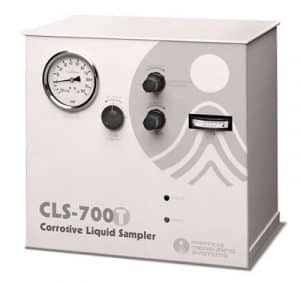Particle Counting in Process Chemicals
Particle counting in process chemicals, especially effervescent and hot process chemicals used in the semiconductor industry, pose unique challenges when trying to measure particle concentration levels. Compression liquid samplers are widely used for both mobile batch sampling and continuous on-line sampling of these chemistries because of their ability to control bubble formation and minimize the effect they have on the resulting data. Samplers also offer tighter process control capabilities by monitoring in close proximity to the product, as in the case of a production wet-bench.
| Definition of the sequence of optimizing a liquid compression sampler | |
| Sequence | Comments |
| Set-up and Installation | Absolutely crucial for generating meaningful particle count data. The location of the sampler relative to the liquid that will be tested can significantly affect the time needed to perform the measurement as well astheresults. |
| Fill | Process of drawing the liquid into the sampler using vacuum. |
| Compression | Step where pressure is applied to the sample, forcing bubbles back into solution prior to measuring particles. |
| Tare | Important step prior to sampling, needed for the proper normalization of data. |
| Sample | Step where particle count and size data is generated. |
| Inter-sample Delay | Used to control the amount of data collected and chemical used. |
Liquid samplers must be optimized for the chemical of interest based on its viscosity, density, vapor pressure and effervescence. Physical parameters such as the location of the sampler from the chemical source, length and diameter of the sample tubing, and fluid elevation changes will affect the settings of the sampler, and therefore must be considered. It is not uncommon for a single sampler to be used with five to ten different chemistries having vastly different physical properties. This broad challenge requires the operator of the equipment understand that technique is a critical determinant in success or failure of the measurement. Experts from Particle Measuring Systems (PMS) discuss general guidelines based on field experience for configuring and optimizing the performance of a liquid compression sampler. A detailed discussion defining a proven sequence for optimizing a compression sampler is given, as well as suggested configurations for the most common process chemistries.
Solution: CLS 700T

The CLS-700 T corrosive liquid particle sampler is a compression sampler combined with a LiQuilaz® particle counter for effective measurement of particles in fluids contained in unpressurized vessels. It is ideally suited for testing chemicals containing dissolved gas, where bubbles could be incorrectly detected as particles. The system eliminates bubbles by pressurizing the sample and keeping the bubbles suspended in solution.
Interested in learning more? Complete the form here to receive expert consultation.
